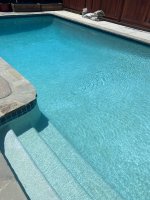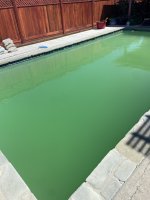Hey all! Been on a bit of a journey with our pool (not the homeowner, roommate) and am seeking some targeted advice. For background, pool pump was out of commission for at least 2 months during the early part of the year and we had a bunch of storms, way too many pucks in floater that whole time (like 5-6), obviously huge algae bloom and pool was green. Cut to me taking over early this month using the TFP way (recommended by an uncle who is long term user) and pool is now super clear and looking great!! Performed OCLT and lost about 1ppm (tested around 8am, not 6am like I meant to) with no CC so we are good there.
For levels we are talking CYA of around 130-150. yes, seriously. Due to not having proper test kit, i went to pool store every day for about 2 weeks, plus a few days following that, then took an average of all CYA values given (from 93ppm all the way up to 161ppm) and am using a current value of 140ppm in PoolMath. It’s not an option for us to drain and refill due to drought restrictions/weather/etc.
To SLAM for the algae, we used liquid chlorine and had to bring our FC into the 30s+ and our current swim target is around 15/16ppm.
My questions are: is there a way I can accurately test my pH with such high FC? At the moment my kit is reading it as 8.2+, however the other day we accidentally fell below 10ppm and the water pH tested at like 7.5 on that day. Should I run with that as the accurate test? Is there a value/multiplier I can use to account or different method (using half pool water/half distilled) to get an accurate result?
Also, I have heard that CYA affects TA readings- is there a way I can adjust my home test results to get an accurate result? My home test put me at 110, whereas most recent pool store test (which says they adjust TA based on CYA) has me 79.
Our other roommate has planned a surprise party and needs the pool to be swimmable by August 4th so I want to make sure I’m able to get accurate FC, CC, pH, and TA results for swimmer safety.
I have attached before and after photos of the pool (we have staining on the surface) as proof of the TFP way!! Also, please feel free to ask me all the questions, I have graphs I made up and keep a log of all home and pool store test results
For levels we are talking CYA of around 130-150. yes, seriously. Due to not having proper test kit, i went to pool store every day for about 2 weeks, plus a few days following that, then took an average of all CYA values given (from 93ppm all the way up to 161ppm) and am using a current value of 140ppm in PoolMath. It’s not an option for us to drain and refill due to drought restrictions/weather/etc.
To SLAM for the algae, we used liquid chlorine and had to bring our FC into the 30s+ and our current swim target is around 15/16ppm.
My questions are: is there a way I can accurately test my pH with such high FC? At the moment my kit is reading it as 8.2+, however the other day we accidentally fell below 10ppm and the water pH tested at like 7.5 on that day. Should I run with that as the accurate test? Is there a value/multiplier I can use to account or different method (using half pool water/half distilled) to get an accurate result?
Also, I have heard that CYA affects TA readings- is there a way I can adjust my home test results to get an accurate result? My home test put me at 110, whereas most recent pool store test (which says they adjust TA based on CYA) has me 79.
Our other roommate has planned a surprise party and needs the pool to be swimmable by August 4th so I want to make sure I’m able to get accurate FC, CC, pH, and TA results for swimmer safety.
I have attached before and after photos of the pool (we have staining on the surface) as proof of the TFP way!! Also, please feel free to ask me all the questions, I have graphs I made up and keep a log of all home and pool store test results





